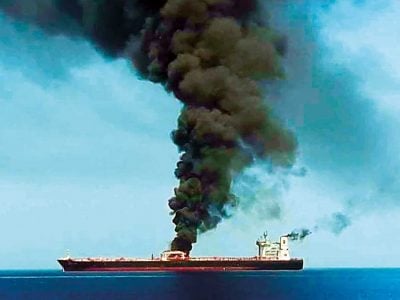Will the China Pakistan Economic Corridor (CPEC) Extend into the Middle East?
Trump’s Tweet Is a Good Pretext to Operationalize the Arabian Aspect of W-CPEC+

It’s inevitable that the China Pakistan Economic Corridor (CPEC) will eventually lead to it strategically expanding into the Gulf, so China and Pakistan should use Trump’s latest tweet urging countries to militarily protect their own oil tankers there to operationalize the Arabian dimension of an expanded W-CPEC+ and indirectly counter India’s (and possibly soon even its “Indo-Pacific” ally Japan’s) naval deployment to the region.
Trump is playing a Machiavellian trick with his latest tweet urging countries to militarily protect their own oil tankers in the Gulf, but that doesn’t mean that he can’t be outwitted and have this plan backfire against him. He told the world that “China gets 91% of its Oil from the Straight, Japan 62%, & many other countries likewise. So why are we protecting the shipping lanes for other countries (many years) for zero compensation. All of these countries should be protecting their own ships on what has always been a dangerous journey. We don’t even need to be there in that the U.S. has just become (by far) the largest producer of Energy anywhere in the world! The U.S. request for Iran is very simple – No Nuclear Weapons and No Further Sponsoring of Terror!” India already deployed its naval and air assets to the region in a provocative show of force against Iran and a sign of fealty to its new American, “Israeli“, and Saudi military-strategic allies, but Trump clearly wants to see the multilateral militarization of this waterway in order to put more pressure on the Islamic Republic.
China gets 91% of its Oil from the Straight, Japan 62%, & many other countries likewise. So why are we protecting the shipping lanes for other countries (many years) for zero compensation. All of these countries should be protecting their own ships on what has always been….
— Donald J. Trump (@realDonaldTrump) June 24, 2019
Specifically calling on China and Japan to dispatch their maritime assets there is intended to create a naval free-for-all that could turn the Strait of Hormuz into what the Gulf of Aden was in the mid-2000s, namely a point of convergence for the world’s navies where each of them can gather intelligence about the other. Japan is India and the US’ “Indo-Pacific” ally for “containing” China and has accordingly been eager to expand its strategic influence in the Afro-Asian (“Indian”) Ocean to this end, which in turn invites China to do the same as it seeks to hedge against their plans. Predictably, the possible deployment of the People’s Liberation Army-Navy (PLAN) in response would immediately be interpreted by the Indians as part of China’s so-called “String of Pearls” strategy for supposedly “encircling” it, thereby encouraging the South Asian state to clinch more weapons deals with the US such as the prospective $10 billion one that it’s reportedly in the process of negotiating. The resultant “security dilemma” is thought to play exactly into the US’ hands because it also gives the Pentagon the opportunity to improve the interoperability of its allies’ naval forces right on Iran’s doorstep.
Even so, that doesn’t mean that China can’t creatively respond by operationalizing the Arabian aspect of W-CPEC+ together with the global pivot state of Pakistan. To explain, it’s inevitable that CPEC‘s economic momentum will lead to it strategically expanding into the Gulf via a maritime connectivity corridor connecting the host state of Pakistan and its Chinese neighbor with Saudi Arabia’s planned Vision 2030 industrialization projects along its eastern coast. A supplementary western component will cross the mainland to connect to Iran, Turkey, and the EU, while the other CPEC+ branch corridors will head north (N-CPEC+) towards Central Asia & Russia and south (S-CPEC+) towards Africa. In the specific context of the present analysis, Trump’s relevant tweet could serve as a pretext for operationalizing the maritime portion of W-CPEC+ through the commencement of joint Chinese-Pakistani naval patrols in the Gulf, which would allow these allied navies to enhance their own interoperability through this real-life training exercise. It’s only a matter of time before this waterway needs to be protected by them anyhow, so it’s best to use this opportunity to begin doing so as soon as possible.
As an additional strategic benefit, China and Pakistan might be able to learn more about the Indian (and possibly soon also Japanese) navy, though so too could India learn more about theirs. Nevertheless, India already deployed its naval and air forces to the region, so the argument can be made that China and Pakistan should do too, especially after Trump invited the entire world to protect their own oil tankers there. Although this naval free-for-all veritably plays into the US’ hands to an extent, Pandora’s Box has already been opened by India’s decision to dispatch its forces there even before Trump publicly suggested it, so the failure to symmetrically respond might lead to a relative disadvantage for the Chinese and Pakistani navies if they allow New Delhi and its “containment” allies to maintain an uncontested long-term presence there. As such, it would be wise to begin brainstorming plans to operationalize W-CPEC+ and improve the Chinese and Pakistani navies’ interoperability since Trump unwittingly gave them the perfect pretext to do so.
*
Note to readers: please click the share buttons above or below. Forward this article to your email lists. Crosspost on your blog site, internet forums. etc.
This article was originally published on Eurasia Future.
Andrew Korybko is an American Moscow-based political analyst specializing in the relationship between the US strategy in Afro-Eurasia, China’s One Belt One Road global vision of New Silk Road connectivity, and Hybrid Warfare. He is a frequent contributor to Global Research.

